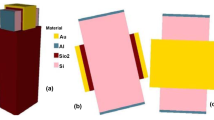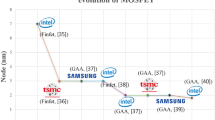Abstract
In this work, the impact of barrier thickness (Tb) on the behavior of InGaAs/InAs/InGaAs composite channel Dual material Double gate (DMDG) high electron mobility transistor (HEMT) devices for high-Frequency applications is explored in detail. The gate length (Lg) of the device is optimized to 50 nm and the device characteristics are explored in detail by varying the barrier thickness (Tb). Dual material gate (DMG) technology at both top and bottom gate of the device, shows a significant increase in drain current, transconductance and higher ION with suppressed short channel effects (SCE). InAs based composite channel DMDG-HEMT devices exhibit a high drain current of Ids = 4.2 × 10−3 A/mm, transconductance (gm) = 4.4 S/mm with reduced gate leakage for 50 nm gate length and barrier thickness of 4 nm for a drain to source voltage (Vds) = 0.5 V. Recessed gate with gate sinking technology stimulates the RF performance metrics with transition frequency fT = 864 GHz and maximum frequency of oscillation fmax = 960 GHz increasing the viability of the device making it suitable for terahertz applications.
Similar content being viewed by others
Data Availability
Not Applicable.
References
Kumar SP, Agrawal A, Chaujar R, Gupta RS, Gupta M (2010) Device linearity and intermodulation distortion comparison of dual material gate and conventional AlGaN/GaN high electron mobility transistor. Microelectron Reliab 51:587–596
Kim D-H, del Alamo JA, Lee J-H, Seo K-S (2005) Performance Evaluation of 50 nm In0.7Ga0.3As HEMTs For Beyond-CMOS Logic Applications. IEEE International Electron Devices meeting, IEDM Technical Digest, Washington DC
Kuo C-I, Hsu H-T, Chang EY, Chang C-Y, Miyamoto Y, Datta S, Radosavljevic M, Huang G-W, Lee C-T RF and Logic Performance Improvement of In0.7Ga0.3As/InAs/In0.7Ga0.3As Composite Channel HEMT Using Gate-Sinking Technology. IEEE Electron Device Lett, Vol. 29, no. 4, 290-293 2008
Kumar RS, Mohanbabu A, Mohankumar N, Raj DG (2017) In0.7Ga0.3As/InAs/In0.7Ga0.3As composite-channel double-gate (DG)-HEMT devices for high-frequency applications. J Comput Electron. https://doi.org/10.1007/s10825-017-0991-x
Kim D-H, del Alamo JA (2008) 30 nm E-mode InAs PHEMTs for THz and Future Logic Applications” IEEE International Electron Devices Meeting, 2008. IEDM
Kim D-H, del Alamo JA (2010) Scalability of Sub-100 nm InAs HEMTs on InP Substrate for Future Logic Applications. IEEE Trans Electron Devices 57(7):1504–1511
Chang E-Y, Kuo C-I, Hsu H-T, Chiang C-Y, Miyamoto Y (2013) InAs Thin-Channel high-Electron-mobility transistors with very high current-gain cutoff frequency for emerging submillimeter-wave applications. Appl Phys Express 6:034001
Endoh A, Yamashita Y, Shinohara K, Higashiwaki M (2001) “Fabrication technology and device performance of sub-50-nm-gate InP-based HEMTs” IEEE international conference on indium phosphide and related materials
Mei X, Yoshida W, Lange M, Lee J, Zhou J, Liu P-H, Leong K, Zamora A, Padilla J, Sarkozy S, Lai R, Deal WR (2015) First demonstration of amplification at 1 THz using 25-nm InP high electron mobility transistor process. IEEE Electron Device Lett 36(4)
Kim D-H, del Alamo JA (2010) 30-nm InAs PHEMTs With fT = 644 GHz and fmax = 681 GHz. IEEE Electron Device Lett 31(8):806–808
Kim D-H, Brar B, del Alamo JA (2011) fT = 688 GHz and fmax = 800 GHz in Lg = 40 nm In0.7Ga0.3As MHEMTs with gm,max > 2.7 mS/μm. Electron Devices Meeting (IEDM), 2011 Washington, DC 5–7
Matsuzaki H, Maruyama T, Koasugi T, Takahashi H, Tokumitsu M, Enoki T (2007) Lateral Scale Down of InGaAs/InAs Composite-Channel HEMTs With Tungsten-Based Tiered Ohmic Structure for 2-S/mm gm and 500-GHz fT. IEEE Trans Electron Devices 54(3):378–384
Gomes UP, Takhar K, Rathi S, Biswas D (2012) Impact of aspect ratio on the logic performance of strained In0.53Ga0.47As Metamorphic HEMT. J Electron Devices 13:939–944
Vasallo BG, Wichmann N, Bollaert S, Roelens Y (2007) Comparison Between the Dynamic Performance of Double- and Single-Gate AlInAs/InGaAs HEMTs. IEEE Trans Electron Devices 54(11):2815–2822
Long W, Ou H, Kuo J, Chin KK (1999) Dual-material gate (DMG) field effect transistors. IEEE Trans Electron Devices 46(5):865–870
Chaudhry A, Kumar MJ (2004) Investigation of the novel attributes of a fully depleted dual-material gate SOI MOSFET. IEEE Trans Electron Devices 51(9):1463–1467
Chakraborty S, Mallik A, Sarkar CK (2008) Subthreshold performance of dual-material gate CMOS devices and circuits for ultralow power analog/mixed-signal applications. IEEE Trans Electron Devices 55(3):827–832
Yuan J, Woo JCS (2005) A novel split-gate MOSFET design realized by a fully solicited gate process for the improvement of transconductance and output resistance. IEEE Electron Device Lett 26(11):829–831
Zhou X (2000) Exploring the novel characteristics of hetero-material gate field-effect transistors (HMGFETs) with gate-material engineering. IEEE Trans Electron Devices 47(1):113–120
Preethi S, Venkatesh M, Karthigai Pandian M, Lakshmi Priya G (2021) Analytical modeling and simulation of gate-all-around Junctionless Mosfet for biosensing applications. Silicon 13:3755–3764. https://doi.org/10.1007/s12633-021-01301-2
Preethi S, Balamurugan NB (2021) Analytical modeling of surrounding gate Junctionless MOSFET using finite differentiation method. Silicon 13:2921–2931. https://doi.org/10.1007/s12633-020-00653-5
Tewari S, Biswas A, Mallik A (2013) Impact of Different Barrier Layers and Indium Content of the Channel on the Analog Performance of InGaAs MOSFETS. IEEE Trans Electron Devices 60(5):1584–1589
Kim D, Alamo JA (2008) Lateral and Vertical Scaling of In0.7Ga0.3As HEMTs for Post-Si-CMOS Logic Applications. IEEE Trans Electron Devices 55:2546–2553
Integrated systems Engineering (ISE) TCAD Manuals (2006) Integr Syst Eng Zurich, Switzerland, Release 10.0
Mohankumar N, Syamal B, Sarkar CK (2010) Influence of channel and gate engineering on the analog and RF performance of DG MOSFETs. IEEE Trans Electron Devices 57(4):820–825
Funding
We did not receive support from any organization for the submitted work and we certify that they have no affiliations with or involvement in any organization or entity with any financial interest or non-financial interest in the subject matter or materials discussed in this manuscript.
Author information
Authors and Affiliations
Contributions
1st author – G.Sujatha: Mathematical modeling and simulation work, Literature review.
2nd author – R.Poornachandran: Study conception and design, Literature review.
3rd author – N.Mohankumar: Supervision, Formal analysis and investigation.
4th author – R.Saravanakumar: Literature review, Original draft preparation.
5th author – M.Karthigai Pandian: Checked the results and validation, Final draft validation.
Corresponding author
Ethics declarations
Ethics Approval and Consent to Participate
Authors freely agreed and gave their consent for the publication of the paper.
Authors Agreement
We declare that the manuscript entitled “Influence of barrier with gate sinking on the performance of InAs Composite Channel DMDG-HEMT Devices for High-Frequency Applications” is original, has not been full or partly published before, and is not currently being considered for publication elsewhere.
We confirm that the manuscript has been read and approved by all named authors and that there are no other persons who satisfied the criteria for authorship but are not listed. We further confirm that the order of authors listed in the manuscript has been approved by the undersigned.
We understand that the Corresponding Author is the sole contact for the editorial process. The corresponding author “Ms.G.Sujatha” is responsible for communicating with the other authors about process, submissions of revisions, and final approval of proofs.”
Conflict of Interest
The authors have NO affiliations with or involvement in any organization or entity with any financial interest (such as honoraria; educational grants; participation in speakers’ bureaus; membership, employment, consultancies, stock ownership, or other equity interest; and expert testimony or patent-licensing arrangements), or non-financial interest (such as personal or professional relationships, affiliations, knowledge or beliefs) in the subject matter or materials discussed in this manuscript.
Additional information
Publisher’s Note
Springer Nature remains neutral with regard to jurisdictional claims in published maps and institutional affiliations.
Rights and permissions
About this article
Cite this article
Sujatha, G., Mohankumar, N., Poornachandran, R. et al. Influence of Barrier with Gate Sinking on the Performance of InAs Composite Channel DMDG-HEMT Devices for High-Frequency Applications. Silicon 14, 10509–10520 (2022). https://doi.org/10.1007/s12633-022-01785-6
Received:
Accepted:
Published:
Issue Date:
DOI: https://doi.org/10.1007/s12633-022-01785-6




